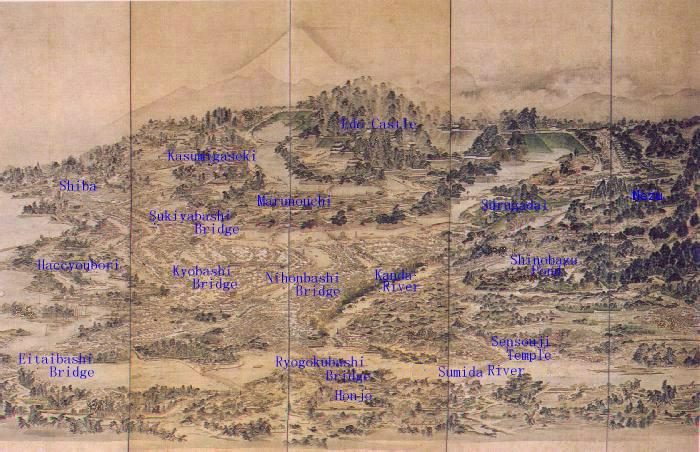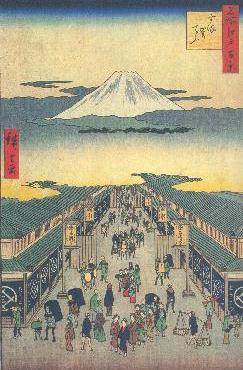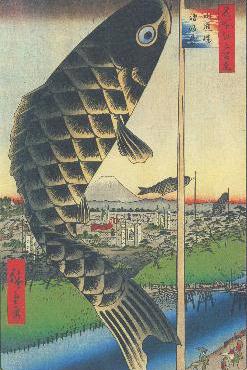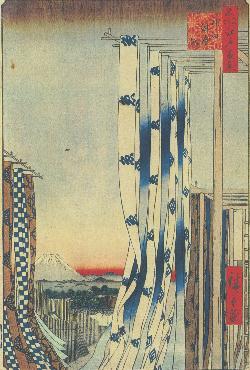
Edo Hitomezu Byoubu
Translated into English by Ms. Asami Masuda
|
Being ordered by Hideyoshi to move to govern the Kanto region,
Ieyasu took up his residence in Edo in 1590.
One reason Ieyasu choose Edo was because of the view of Mt. Fuji there.
Ieyasu rebuilt the Edo castle. In the inner circle ( Honmaru ) of the Edo castle the main tower ( Tensyukaku ) stood, and from the town of Edo, Mt. Fuji and the castle tower were seen standing together which showed the glory of the Shogun family to the world. The main tower was burned down in a fire in 1657, and was never rebuilt since then. Ieyasu began to rebuild the city of Edo. He made the downtown ( shitamachi ) area in the place of Kanda, Nihonbashi, Kyobashi and Ginza as known as today, and laid out roads in a regular grid and broke the area up in square towns ( machi ). He also built bridges such as Nihonbasi and Edobasi, and arranged the streets in town that led into five main highways ( Go-kaido ) which started from Nihonbasi. There were many slopes and hills to look at Mt.Fuji here and there in the Edo city. Mt.Fuji was thought of as a part of Edo. Some representatives in which this sense was embodied are "Folding screen painting of Bird's-eye view of Edo" ( "Edo Hitomezu Byoubu" ) and "View of Edo" ( "Edo Ezu"). In these pictures, Mt. Fuji drawn larger than the actual one is blended in better with the town of Edo, which makes the drawing well balanced altogether. There are also many Mt. Fuji views seen from the city or the outskirts of Edo in Hokusai Katsusika's "Thirty-six Views of Mount Fuji" ( "Fugaku Sanjyurokkei" ) and "One Hundred Views of Mount Fuji" ( "Fugaku Hyakkei" ), and Hiroshige Ando's "One Hundred Famous Views of Edo" ( "Meisyo Edo Hyakkei" ). |


|

|

|
| Suruga Street | Water Supply Bridge st Suruga Terrace | Dyers' Quarter, Kanda |
According to the slope ( saka ) item in "The Edo-Tokyo Encyclopeadia" (in Japanese, Edited by Shinzo Ogi et al., 1987, Published by Sanseido), names of slopes were written down in maps and records for the first time in the late 17th century. There were about 300 slopes with names in the Edo city, eighteen of which had the name Fuji viewing slope ( Fujimizaka ).
Mt. Fuji became an object of religion to the townspeople of Edo,
and an organization for conducting a religious activities ( Fujiko ) was born. The townspeople who could not go to Mt. Fuji gathered together to make Fujiko in hopes of shareing their good luck from the mountain, and built miniatures of Mt. Fuji ( Fujidukas ) in many places. Fujiko protected and maintained Fujidukas by holding festivals.
|
|
|
|
|
|
Japanese Home Page |
|
|
English page |